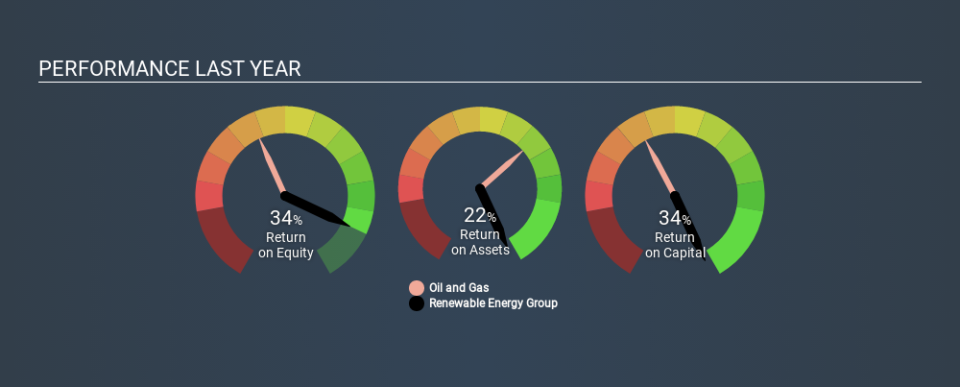A Close Look At Renewable Energy Group, Inc.’s (NASDAQ:REGI) 34% ROCE

Today we'll look at Renewable Energy Group, Inc. (NASDAQ:REGI) and reflect on its potential as an investment. Specifically, we'll consider its Return On Capital Employed (ROCE), since that will give us an insight into how efficiently the business can generate profits from the capital it requires.
First up, we'll look at what ROCE is and how we calculate it. Second, we'll look at its ROCE compared to similar companies. And finally, we'll look at how its current liabilities are impacting its ROCE.
Return On Capital Employed (ROCE): What is it?
ROCE is a measure of a company's yearly pre-tax profit (its return), relative to the capital employed in the business. In general, businesses with a higher ROCE are usually better quality. Ultimately, it is a useful but imperfect metric. Author Edwin Whiting says to be careful when comparing the ROCE of different businesses, since 'No two businesses are exactly alike.
So, How Do We Calculate ROCE?
The formula for calculating the return on capital employed is:
Return on Capital Employed = Earnings Before Interest and Tax (EBIT) ÷ (Total Assets - Current Liabilities)
Or for Renewable Energy Group:
0.34 = US$412m ÷ (US$1.8b - US$588m) (Based on the trailing twelve months to December 2019.)
Therefore, Renewable Energy Group has an ROCE of 34%.
Check out our latest analysis for Renewable Energy Group
Does Renewable Energy Group Have A Good ROCE?
ROCE is commonly used for comparing the performance of similar businesses. Renewable Energy Group's ROCE appears to be substantially greater than the 7.9% average in the Oil and Gas industry. We consider this a positive sign, because it suggests it uses capital more efficiently than similar companies. Putting aside its position relative to its industry for now, in absolute terms, Renewable Energy Group's ROCE is currently very good.
In our analysis, Renewable Energy Group's ROCE appears to be 34%, compared to 3 years ago, when its ROCE was 8.7%. This makes us think about whether the company has been reinvesting shrewdly. You can see in the image below how Renewable Energy Group's ROCE compares to its industry. Click to see more on past growth.
Remember that this metric is backwards looking - it shows what has happened in the past, and does not accurately predict the future. ROCE can be deceptive for cyclical businesses, as returns can look incredible in boom times, and terribly low in downturns. ROCE is only a point-in-time measure. Remember that most companies like Renewable Energy Group are cyclical businesses. Future performance is what matters, and you can see analyst predictions in our free report on analyst forecasts for the company.
What Are Current Liabilities, And How Do They Affect Renewable Energy Group's ROCE?
Current liabilities include invoices, such as supplier payments, short-term debt, or a tax bill, that need to be paid within 12 months. The ROCE equation subtracts current liabilities from capital employed, so a company with a lot of current liabilities appears to have less capital employed, and a higher ROCE than otherwise. To counteract this, we check if a company has high current liabilities, relative to its total assets.
Renewable Energy Group has current liabilities of US$588m and total assets of US$1.8b. As a result, its current liabilities are equal to approximately 33% of its total assets. Renewable Energy Group's ROCE is boosted somewhat by its middling amount of current liabilities.
The Bottom Line On Renewable Energy Group's ROCE
Even so, it has a great ROCE, and could be an attractive prospect for further research. There might be better investments than Renewable Energy Group out there, but you will have to work hard to find them . These promising businesses with rapidly growing earnings might be right up your alley.
If you are like me, then you will not want to miss this free list of growing companies that insiders are buying.
If you spot an error that warrants correction, please contact the editor at editorial-team@simplywallst.com. This article by Simply Wall St is general in nature. It does not constitute a recommendation to buy or sell any stock, and does not take account of your objectives, or your financial situation. Simply Wall St has no position in the stocks mentioned.
We aim to bring you long-term focused research analysis driven by fundamental data. Note that our analysis may not factor in the latest price-sensitive company announcements or qualitative material. Thank you for reading.

 Yahoo Finance
Yahoo Finance 
